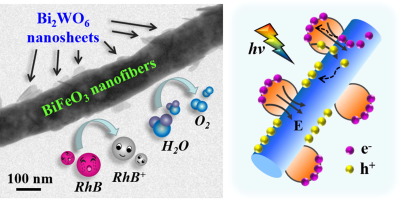当前位置:
X-MOL 学术
›
J. Colloid Interface Sci.
›
论文详情
Our official English website, www.x-mol.net, welcomes your feedback! (Note: you will need to create a separate account there.)
Discrete heterojunction nanofibers of BiFeO3/Bi2WO6: Novel architecture for effective charge separation and enhanced photocatalytic performance.
Journal of Colloid and Interface Science ( IF 9.9 ) Pub Date : 2020-03-27 , DOI: 10.1016/j.jcis.2020.03.096 Ran Tao 1 , Xinghua Li 1 , Xiaowei Li 1 , Shuai Liu 1 , Changlu Shao 1 , Yichun Liu 1
Journal of Colloid and Interface Science ( IF 9.9 ) Pub Date : 2020-03-27 , DOI: 10.1016/j.jcis.2020.03.096 Ran Tao 1 , Xinghua Li 1 , Xiaowei Li 1 , Shuai Liu 1 , Changlu Shao 1 , Yichun Liu 1
Affiliation

|
Designing and constructing one-dimensional (1D) discrete heterojunctions comprise an ideal strategy to improve the charge-separation efficiency and enhance the photocatalytic activities of semiconductor materials. Here, a novel architecture of discrete heterojunction nanofibers (DH-NFs) was obtained by growing Bi2WO6 nanosheets (NSs) on electrospun BiFeO3 nanofibers (NFs) via solvothermal technology. The charge-separation efficiency of BiFeO3/Bi2WO6 DH-NFs was approximately 2 times higher than that of BiFeO3 NFs and Bi2WO6 NSs. As expected, the BiFeO3/Bi2WO6 DH-NFs exhibited enhanced photocatalytic activities for oxygen evolution and RhB degradation. The reaction rates of BiFeO3/Bi2WO6 DH-NFs for oxygen evolution and RhB degradation were 18.3 and 36.7 times higher, respectively, than those of BiFeO3 NFs, and 31.9 and 8.7 times higher than those of Bi2WO6 NSs, respectively. The improved charge-separation efficiency and enhanced photocatalytic activities of BiFeO3/Bi2WO6 DH-NFs could be attributed to the following three points. The 1D heterojunctions could realize the separation and axial transport of photogenerated charges. The discrete structure could facilitate the spatial separation of redox reaction sites as well as photogenerated charges. The high surface area of BiFeO3/Bi2WO6 DH-NFs might provide more active sites for photocatalytic reaction. Moreover, the BiFeO3/Bi2WO6 DH-NFs possessed good recycling performance owing to the magnetic-separable property derived from the ferromagnetic behavior of BiFeO3.
中文翻译:

BiFeO3 / Bi2WO6的离散异质结纳米纤维:有效电荷分离和增强光催化性能的新型结构。
设计和构造一维(1D)离散异质结是一种理想的策略,可以提高电荷分离效率并增强半导体材料的光催化活性。在这里,通过溶剂热技术在电纺BiFeO3纳米纤维(NFs)上生长Bi2WO6纳米片(NSs),获得了一种新型的离散异质结纳米纤维(DH-NFs)的体系结构。BiFeO3 / Bi2WO6 DH-NFs的电荷分离效率约为BiFeO3 NFs和Bi2WO6 NS的2倍。如预期的那样,BiFeO3 / Bi2WO6 DH-NFs对氧的释放和RhB的降解表现出增强的光催化活性。BiFeO3 / Bi2WO6 DH-NFs对氧气释放和RhB降解的反应速率分别比BiFeO3 NFs高18.3和36.7倍,分别为31.9和8。比Bi2WO6 NS高7倍。BiFeO3 / Bi2WO6 DH-NFs电荷分离效率的提高和光催化活性的提高可归因于以下三点。一维异质结可以实现光生电荷的分离和轴向传输。离散结构可以促进氧化还原反应位点以及光生电荷的空间分离。BiFeO3 / Bi2WO6 DH-NFs的高表面积可能为光催化反应提供更多的活性位点。此外,BiFeO3 / Bi2WO6 DH-NFs具有良好的循环利用性能,这归因于BiFeO3的铁磁行为具有磁性。BiFeO3 / Bi2WO6 DH-NFs电荷分离效率的提高和光催化活性的提高可归因于以下三点。一维异质结可以实现光生电荷的分离和轴向传输。离散结构可以促进氧化还原反应位点以及光生电荷的空间分离。BiFeO3 / Bi2WO6 DH-NFs的高表面积可能为光催化反应提供更多的活性位点。此外,BiFeO3 / Bi2WO6 DH-NFs具有良好的循环利用性能,这归因于BiFeO3的铁磁行为具有磁性。BiFeO3 / Bi2WO6 DH-NFs电荷分离效率的提高和光催化活性的提高可归因于以下三点。一维异质结可以实现光生电荷的分离和轴向传输。离散结构可以促进氧化还原反应位点以及光生电荷的空间分离。BiFeO3 / Bi2WO6 DH-NFs的高表面积可能为光催化反应提供更多的活性位点。此外,BiFeO3 / Bi2WO6 DH-NFs具有良好的循环利用性能,这归因于BiFeO3的铁磁行为具有磁性。离散结构可以促进氧化还原反应位点以及光生电荷的空间分离。BiFeO3 / Bi2WO6 DH-NFs的高表面积可能为光催化反应提供更多的活性位点。此外,BiFeO3 / Bi2WO6 DH-NFs具有良好的循环利用性能,这归因于BiFeO3的铁磁行为产生的磁性分离特性。离散结构可以促进氧化还原反应位点以及光生电荷的空间分离。BiFeO3 / Bi2WO6 DH-NFs的高表面积可能为光催化反应提供更多的活性位点。此外,BiFeO3 / Bi2WO6 DH-NFs具有良好的循环利用性能,这归因于BiFeO3的铁磁行为具有磁性。
更新日期:2020-03-28
中文翻译:

BiFeO3 / Bi2WO6的离散异质结纳米纤维:有效电荷分离和增强光催化性能的新型结构。
设计和构造一维(1D)离散异质结是一种理想的策略,可以提高电荷分离效率并增强半导体材料的光催化活性。在这里,通过溶剂热技术在电纺BiFeO3纳米纤维(NFs)上生长Bi2WO6纳米片(NSs),获得了一种新型的离散异质结纳米纤维(DH-NFs)的体系结构。BiFeO3 / Bi2WO6 DH-NFs的电荷分离效率约为BiFeO3 NFs和Bi2WO6 NS的2倍。如预期的那样,BiFeO3 / Bi2WO6 DH-NFs对氧的释放和RhB的降解表现出增强的光催化活性。BiFeO3 / Bi2WO6 DH-NFs对氧气释放和RhB降解的反应速率分别比BiFeO3 NFs高18.3和36.7倍,分别为31.9和8。比Bi2WO6 NS高7倍。BiFeO3 / Bi2WO6 DH-NFs电荷分离效率的提高和光催化活性的提高可归因于以下三点。一维异质结可以实现光生电荷的分离和轴向传输。离散结构可以促进氧化还原反应位点以及光生电荷的空间分离。BiFeO3 / Bi2WO6 DH-NFs的高表面积可能为光催化反应提供更多的活性位点。此外,BiFeO3 / Bi2WO6 DH-NFs具有良好的循环利用性能,这归因于BiFeO3的铁磁行为具有磁性。BiFeO3 / Bi2WO6 DH-NFs电荷分离效率的提高和光催化活性的提高可归因于以下三点。一维异质结可以实现光生电荷的分离和轴向传输。离散结构可以促进氧化还原反应位点以及光生电荷的空间分离。BiFeO3 / Bi2WO6 DH-NFs的高表面积可能为光催化反应提供更多的活性位点。此外,BiFeO3 / Bi2WO6 DH-NFs具有良好的循环利用性能,这归因于BiFeO3的铁磁行为具有磁性。BiFeO3 / Bi2WO6 DH-NFs电荷分离效率的提高和光催化活性的提高可归因于以下三点。一维异质结可以实现光生电荷的分离和轴向传输。离散结构可以促进氧化还原反应位点以及光生电荷的空间分离。BiFeO3 / Bi2WO6 DH-NFs的高表面积可能为光催化反应提供更多的活性位点。此外,BiFeO3 / Bi2WO6 DH-NFs具有良好的循环利用性能,这归因于BiFeO3的铁磁行为具有磁性。离散结构可以促进氧化还原反应位点以及光生电荷的空间分离。BiFeO3 / Bi2WO6 DH-NFs的高表面积可能为光催化反应提供更多的活性位点。此外,BiFeO3 / Bi2WO6 DH-NFs具有良好的循环利用性能,这归因于BiFeO3的铁磁行为产生的磁性分离特性。离散结构可以促进氧化还原反应位点以及光生电荷的空间分离。BiFeO3 / Bi2WO6 DH-NFs的高表面积可能为光催化反应提供更多的活性位点。此外,BiFeO3 / Bi2WO6 DH-NFs具有良好的循环利用性能,这归因于BiFeO3的铁磁行为具有磁性。



























 京公网安备 11010802027423号
京公网安备 11010802027423号